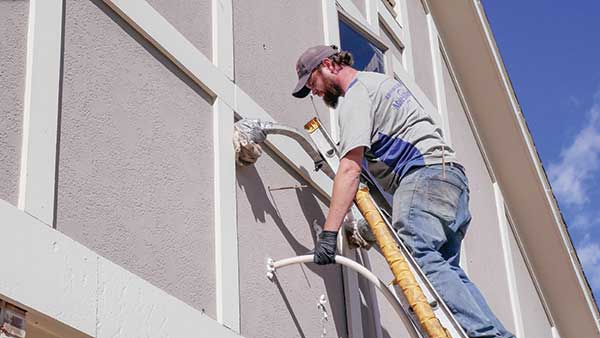How to Install RetroFoam in Homes with Hardie Board Siding
injection foam insulation | RetroFoam insulation | foam university


Homeowners with Hardie board siding often wonder if RetroFoam insulation can be added to their exterior walls from the outside.
The quick answer is yes. Hardie board siding, or cement board siding, is a durable and beautiful exterior option that can be insulated with injection foam.
In this article, we’ll walk you through the process of Hardie Board removal, the injection foam insulation install process, and how to safely reinstall the siding. Whether you’re a homeowner or a DIY enthusiast, this article will help you understand the ins and outs of the process.
What is Hardie Board?
Before diving into the injection foam installation process, let’s clarify what Hardie board is.
Hardie board is a type of cement board siding known for its durability and aesthetic appeal. Due to its resilience, it’s a popular choice in regions prone to harsh weather conditions, such as hailstorms.
If you have Hardie board siding, you already know how its textured and decorative finish enhances your home’s exterior.
Installing RetroFoam in Homes with Hardie Board Siding
From preparing the exterior to replacing the siding, here’s what you need to know about how RetroFoam install crews work with Hardie Board.
Step One: Preparing for Installation
The first step in installing RetroFoam in a home with Hardie board siding is to prepare the exterior.
Hardie board is rigid and can withstand the removal process, but it’s essential to be cautious to avoid damaging the boards.
- Cutting the Caulk: Crews will carefully cut the caulk to loosen the boards if the Hardie board is caulked at the seams. This step ensures that the boards can be pried off without tearing or cracking.
- Prying Off the Boards: The install crew will use a pry bar and other appropriate tools to lift the boards gently. It’s important to apply even pressure across the board to prevent cracking. While Hardie board is durable, uneven pressure can still cause damage.
Step Two: Drilling Access Holes
Once the Hardie board siding is removed, the next step is to drill holes into the exterior walls to access the wall cavities.
These holes will allow the injection foam insulation to fill the spaces and provide superior insulation for your home.
- Drilling: Crews will use a drill to create evenly-spaced holes in the wall cavities. The size and placement of these holes are crucial for ensuring that the foam fills the entire cavity.
- Injecting Foam: After drilling holes, the foam is injected into the wall cavities. The injection foam will fill all of the nooks and crannies, providing excellent thermal resistance and sound dampening.
Step Three: Reinstalling Hardie Board
With the insulation in place, it’s time to reinstall the Hardie board siding.
This step requires precision to ensure that the boards are securely fastened and that your home's aesthetic appeal remains intact.
- Using a Nail Gun: A nail gun with an angled head is ideal for reinstalling the Hardie board. The angled nails help hide the nail heads, maintaining the board’s clean look.
- Ensuring Even Installation: It’s best to have at least two people working on this step to keep the boards level and prevent drooping, which can increase the risk of cracking.
Step Four: Finishing Touches
Finally, after the boards are reinstalled, the crew will check for gaps or areas that need additional caulking.
Ensuring a tight air seal will help maintain the insulation’s effectiveness and protect your home from the elements.
Adding RetroFoam Insulation to Your Exterior Walls
Hardie board-sided homes can be effectively insulated with injection foam insulation like RetroFoam.
The process involves careful preparation, drilling access holes, injecting the foam, and securely reinstalling the boards. This is why it’s so important to hire an experienced insulation contractor.
If you’re ready to take back the comfort and control of your home, visit our Find a Dealer page to connect with your local RetroFoam dealer.
Related Articles
Adding Insulation to Exterior Walls: Installing RetroFoam with Different Siding Types
The Top Three Reasons to Add Insulation to Existing Walls When Residing a House
How Do RetroFoam Installers Know the Cavity is Full When Insulating Existing Walls?
About Eric Garcia
Eric brings his knowledge and training in building science, training in spray and injection foams from the manufacturers, more than eight years installing foam insulation, as well as selling and managing in the foam insulation industry. He is also BPI and Dale Carnegie certified and has taken several building science courses, including air sealing and building envelope. Eric is the Professor of Foam on our educational YouTube series Foam University. Even when Eric is off he is usually still “working” or thinking about work, but when he can get away he enjoys camping, hiking, hunting, and woodworking.



